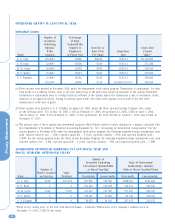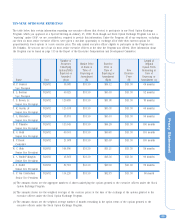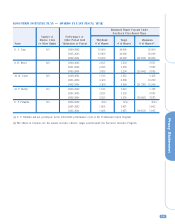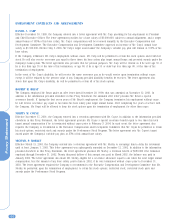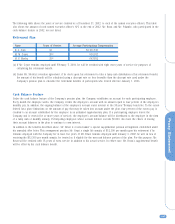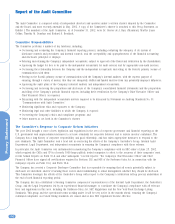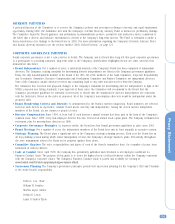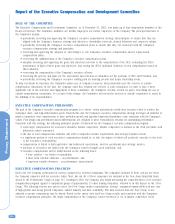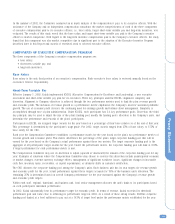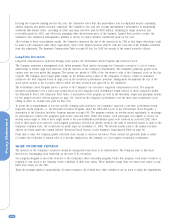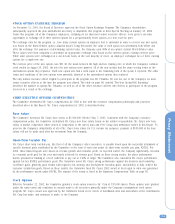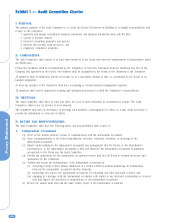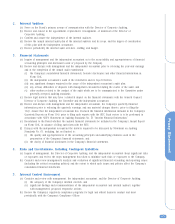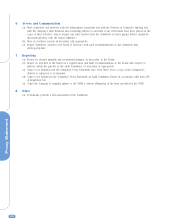Kodak 2002 Annual Report Download - page 113
Download and view the complete annual report
Please find page 113 of the 2002 Kodak annual report below. You can navigate through the pages in the report by either clicking on the pages listed below, or by using the keyword search tool below to find specific information within the annual report.
Proxy Statement
108
BACKGROUND
In July 2002, the Board merged its Committee on Directors and Public Policy Committee to form a newly created committee entitled
the “Corporate Responsibility and Governance Committee.” While the Board of Directors has long believed that strong corporate
governance is key to the Company’s long-term success, this action was taken largely to heighten the awareness and importance of good
corporate governance within the Company.
The purpose of this new Committee is to oversee the Company’s corporate governance structure, recommend individuals to the Board
for nomination as members of the Board and its committees, lead the Board in its periodic review of Board performance and oversee
the Company’s activities in the areas of environmental and social responsibility, diversity and equal employment opportunity. The
Committee is required to consist of at least three directors, all of whom meet the independence requirements of the New York Stock
Exchange.
NEW LEGISLATIVE AND REGULATORY REQUIREMENTS
During its first year, the Committee, as did both the Audit Committee and Executive Compensation and Development Committee, spent
considerable time reviewing, analyzing and evaluating the provisions of the Sarbanes-Oxley Act and the proposed new listing standards
of the New York Stock Exchange regarding corporate governance policies and processes. The results of these reviews found that the
Company’s current policies, procedures and standards already satisfy many of these requirements. As a result of its reviews, the
Committee took a number of steps in anticipation of the adoption of the requirements in final form. These include incorporating
conforming requirements into its new charter, reviewing the Company’s standards for determining director independence, deliberating
revisions to the Company’s governance guidelines, approving the formation of a director education program, and recommending the
appointment of a presiding director. With the Company’s assistance, the Committee, the Board and each of the Board’s other
committees will continue to monitor the progress of pending legislative and regulatory initiatives and review all applicable charters,
policies, procedures and practices to ensure full compliance by the Company.
PRESIDING DIRECTOR
At the Committee’s recommendation, the Board of Directors created the new position of presiding director effective February 18, 2003.
Absent a Board decision to the contrary, the presiding director of the Board will be the longest tenured independent member of the
Board. The primary function of the presiding director is to ensure that the Board operates independent of management. As the longest-
tenured member of the Board, Richard Braddock was designated the Company’s presiding director, effective February 18, 2003.
GOVERNANCE GUIDELINES
The Board of Directors adopted a set of governance guidelines on July 27, 2001. These governance guidelines reflect the principles by
which the Company operates. As previously mentioned, the Committee has already reviewed and proposed changes to these guidelines
in anticipation of the finalization of the NYSE proposed standards. In their current form, the guidelines address an array of governance
issues and principles including: director independence, committee independence, management succession, mandatory director
retirement, annual Board evaluation, periodic director evaluation, director stock ownership, director nominations, and executive
sessions of the independent directors. The Company’s governance guidelines are available for viewing on the Company’s website at
www.kodak.com/US/en/corp/principles/governance.shtml.
CORPORATE RESPONSIBILITY PRINCIPLES
Upon recommendation of the Committee, the Company adopted in November 2002 corporate responsibility principles. Underlying these
principles is the belief that “doing well by shareholders, also means doing right by customers, employees, neighbors, and suppliers.”
Among the principles addressed are the following:
• Kodak conducts its business activities to high and ethical standards;
• Kodak respects internationally accepted legal principles, and obeys the laws of countries in which it does business;
• Kodak is committed to sound corporate governance;
• Kodak conducts its business activities in an environmentally responsible manner;
• Kodak promotes a work environment of equal opportunity for all employees, and treats its employees in non-discriminatory
manner; and
• Kodak is committed to employing a diverse work force, and to building and maintaining an inclusive work environment.
The full text of the Company’s corporate responsibility principles is available for viewing in the “About Kodak” section of the Company’s
web site at www.kodak.com/US/en/corp/principles.
Report of the Corporate Responsibility and Governance Committee


